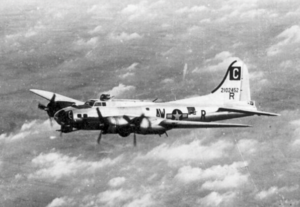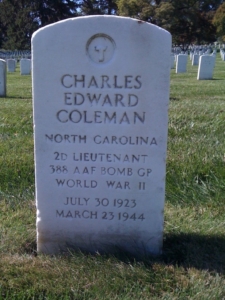Scroll of Honor – Charles Edward Coleman
Rammabschuss
Written by: Kelly Durham
Charles Edward Coleman and Willi Maximowitz never formally met, but their encounter in the unfriendly skies over wartime Germany would have tragic results. Coleman would be at the controls of an American heavy bomber, Maximowitz was the pilot of a German fighter.
Coleman arrived on the Clemson campus in 1940 after attending Carlisle Military School in Bamberg. A textile engineering major from Charlotte, North Carolina, Coleman was assigned to K Company, 3rd Battalion of the 1st Regiment of the Cadet Brigade. With the outbreak of war, Coleman broke off his studies and volunteered for the Army Air Force.
Coleman earned his pilot’s wings in September 1943 at Turner Field near Albany, Georgia and was selected for multi-engine aircraft. In October, he married Betty Hunneycutt of Charlotte. After completing his combat crew training in the B-17 bomber, he shipped overseas to England where he joined the 388th Bomb Group at Knettishall.
Second Lieutenant Coleman’s second combat mission was to bomb aircraft production facilities in the vicinity of Brunswick,  Germany as the copilot of Pegasus Too, piloted by First Lieutenant L. Wilson. From 0600 to 0651 on March 23, 1944, thirty-one aircraft took off from the 388th’s base. Assembling into formation without difficulty, the aircraft turned to the east. According to the group’s mission report, the formation crossed the enemy coast ahead of schedule. This efficiency led to disaster. “Consequently,” the report continues, “no friendly fighter escort was met until the formation was near the IP,” the point from which its bomb run commenced. As a result, thirty-five to forty-five enemy fighters, mostly Focke-Wulf 190s, attacked the formation between 0955 and 1010 hours. “The attacks were vicious.” The German fighters attacked from above and to the left front of the bombers. Two of the bombers were shot down. Coleman’s aircraft, however, was attacked in a less conventional manner.
Germany as the copilot of Pegasus Too, piloted by First Lieutenant L. Wilson. From 0600 to 0651 on March 23, 1944, thirty-one aircraft took off from the 388th’s base. Assembling into formation without difficulty, the aircraft turned to the east. According to the group’s mission report, the formation crossed the enemy coast ahead of schedule. This efficiency led to disaster. “Consequently,” the report continues, “no friendly fighter escort was met until the formation was near the IP,” the point from which its bomb run commenced. As a result, thirty-five to forty-five enemy fighters, mostly Focke-Wulf 190s, attacked the formation between 0955 and 1010 hours. “The attacks were vicious.” The German fighters attacked from above and to the left front of the bombers. Two of the bombers were shot down. Coleman’s aircraft, however, was attacked in a less conventional manner.
Unteroffizier Willi Maximowitz was the pilot of one of the attacking German fighters. Chased by an American P-38 fighter

Willi Maximowtizi in his FW 190
which had now caught up with the bombers, Maximowitz streaked through the American formation and aimed his nimble fighter at Coleman’s big bomber. As he barreled past, Maximowitz lowered his wing and clipped off five feet of the B-17’s horizontal stabilizer—the tail plane that controlled the bomber’s pitch angle. Coleman and Wilson, were unable to control the airplane and it began to spin. Crewmen from other bombers in the formation saw three parachutes escape from the plane, which subsequently crashed near Steyerberg, south of Bremen. Coleman, Wilson and five of their crew were killed. The three who successfully escaped the spinning bomber were captured and made prisoners of war.
Maximowitz likewise was forced to bail out of his damaged fighter, the wing of which had been sheared off. Nonetheless, he was credited with his third enemy bomber, this one “Rammabschuss”–shot down by ramming. Maximowitz would go on to shoot down a total of fifteen American bombers before his fighter group was transferred to the Eastern Front in early 1945. He would add twelve Soviet aircraft to his tally of aerial victims before failing to return from a combat mission on April 20, 1945.
 Second Lieutenant Charles Edward Coleman was awarded the Purple Heart. He was survived by his wife and his parents. He is buried in Arlington National Cemetery.
Second Lieutenant Charles Edward Coleman was awarded the Purple Heart. He was survived by his wife and his parents. He is buried in Arlington National Cemetery.
For more information about Charles Edward Coleman see:
https://soh.alumni.clemson.edu/scroll/charles-edward-coleman/
For additional information about Clemson University’s Scroll of Honor visit:
